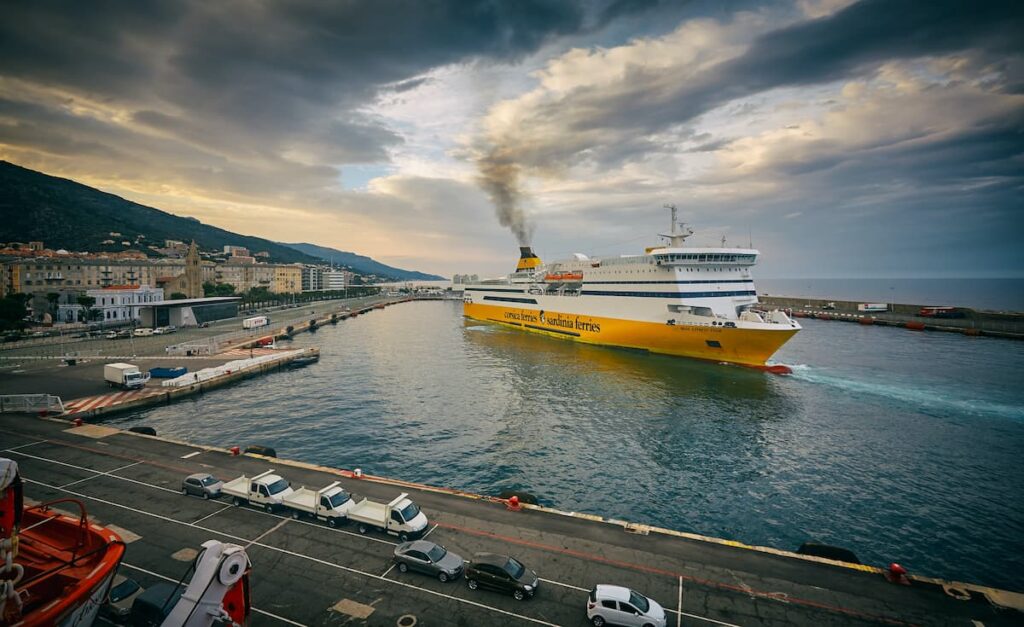Cargo ships are responsible for significant amounts of carbon dioxide emissions, with estimates suggesting that cargo ship CO2 emissions account for around 3% of global greenhouse gas emissions.
While this may seem relatively small compared to other modes of transportation, it is important to note that cargo ships are responsible for transporting around 90% of the world’s goods.
In comparison, cars and trucks are responsible for around 14% of global emissions, while planes account for around 2.5%.

It is clear that cargo ships play a significant role in global emissions, but what makes them so polluting? One factor is the type of fuel used by cargo ships, which is typically heavy fuel oil.
This type of fuel is cheap and widely available, but it is also extremely dirty and emits high levels of pollutants, including sulfur dioxide and nitrogen oxides. In addition, cargo ships are often powered by large engines that burn vast amounts of fuel, contributing to their high levels of emissions.
Despite their significant impact on the environment, cargo ships are often overlooked in discussions about climate change and transportation emissions.
However, as the world becomes increasingly reliant on global trade, it is important to consider the role that cargo ships play in contributing to greenhouse gas emissions. Now let’s explore the environmental impact of cargo ships in more detail, comparing their emissions to those of other modes of transportation such as cars, planes, and trains.
CO2 Emissions of Cargo Ships
Cargo ships are one of the most important modes of transportation for goods and commodities around the world. However, they are also responsible for a significant amount of greenhouse gas emissions. In this section, we will explore the CO2 emissions of cargo ships and compare them with other modes of transportation.
Comparison with Cars
According to the Environmental Protection Agency (EPA), transportation accounts for about 28% of greenhouse gas emissions in the United States, and cars and trucks make up the majority of those emissions.
In comparison, cargo ships emit significantly less CO2 per ton of cargo transported than cars and trucks. In fact, cargo ships emit up to 90% less CO2 per ton-mile than trucks.
Comparison with Planes
Air travel is one of the most carbon-intensive forms of transportation. In 2018, the aviation industry was responsible for about 2.4% of global CO2 emissions.
While cargo planes are more fuel-efficient than passenger planes, they still emit more CO2 per ton of cargo transported than cargo ships. Cargo ships emit up to 50 times less CO2 per ton-mile than cargo planes.
Comparison with Trains
Trains are often touted as one of the most environmentally friendly modes of transportation and for good reason. Trains emit significantly less CO2 per ton of cargo transported than trucks, and they are also more fuel-efficient. However, cargo ships still emit less CO2 per ton-mile than trains. Cargo ships emit up to 12 times less CO2 per ton-mile than trains.
In conclusion, while cargo ships are responsible for a significant amount of greenhouse gas emissions, they are still more environmentally friendly than other modes of transportation such as cars, planes, and trains. However, there is still room for improvement in terms of reducing emissions from cargo ships.

Impact of Cargo Ship Emissions on the Environment
Cargo ships are responsible for a significant amount of carbon dioxide emissions, which contribute to climate change and air pollution. According to the International Maritime Organization (IMO), shipping accounts for approximately 2.5% of global greenhouse gas emissions, with cargo ships being the largest contributor.
In comparison to other modes of transportation, cargo ships emit significantly more carbon dioxide per unit of cargo transported. For example, a single large container ship can emit as much pollution as 50 million cars. This is due to the fact that cargo ships run on heavy fuel oil, which is a low-quality fuel that emits high levels of sulfur dioxide and nitrogen oxides.
The impact of cargo ship emissions on the environment is significant. The emissions from cargo ships contribute to the warming of the planet, leading to melting ice caps, rising sea levels, and extreme weather events. In addition, the pollutants released by cargo ships can have negative effects on human health, including respiratory problems, heart disease, and cancer.
Furthermore, cargo ships are responsible for a significant amount of air pollution in coastal areas and port cities. This pollution can have a negative impact on the health and well-being of local communities, particularly those living in disadvantaged areas.
Efforts are being made to reduce the impact of cargo ship emissions on the environment. The IMO has set a goal of reducing carbon emissions from shipping by at least 50% by 2050 compared to 2008 levels. This can be achieved through the use of cleaner fuels, such as liquefied natural gas (LNG), and the implementation of energy-efficient technologies.
In conclusion, cargo ship emissions have a significant impact on the environment and human health. Efforts must be made to reduce these emissions and mitigate their negative effects.
Current Regulations and Initiatives to Reduce CO2 Emissions from Cargo Ships
The shipping industry is responsible for a significant portion of global carbon dioxide emissions, with cargo ships alone accounting for around 3% of total emissions. As a result, there has been an increasing focus on reducing emissions from the sector in recent years.
One of the primary regulations aimed at reducing emissions from cargo ships is the International Maritime Organization’s (IMO) Energy Efficiency Design Index (EEDI).
The EEDI sets minimum energy efficiency requirements for new ships and aims to reduce emissions by encouraging the use of more efficient technologies and designs. The IMO has also implemented the Ship Energy Efficiency Management Plan (SEEMP), which requires ships to develop and implement plans to improve their energy efficiency and reduce emissions.
In addition to these regulations, there are several initiatives aimed at reducing emissions from cargo ships. The Global Maritime Forum’s Getting to Zero Coalition aims to reduce the shipping industry’s emissions to zero by 2050, while the Clean Cargo Working Group, which includes major shipping companies and cargo owners, aims to improve the environmental performance of the shipping industry through collaboration and sharing of best practices.
Several shipping companies have also taken steps to reduce their emissions. For example, Maersk, the world’s largest container shipping company, has set a target of net-zero emissions by 2050 and is investing in alternative fuels such as biofuels and hydrogen. Similarly, CMA CGM, the fourth-largest container shipping company, has committed to becoming carbon-neutral by 2050 and has invested in LNG-powered ships.
Overall, while there is still much work to be done to reduce emissions from the shipping industry, there are several regulations and initiatives in place aimed at achieving this goal. Shipping companies are also taking steps to reduce their emissions, which is a positive sign for the future of the industry.
Future of Cargo Ship Emissions Reduction
Cargo ships are responsible for a significant amount of carbon dioxide emissions globally. Although they are an essential component of international trade, they contribute to air pollution, climate change, and other environmental problems.
As such, efforts are being made to reduce their carbon footprint. The future of cargo ship emissions reduction lies in technological advancements and alternative fuels.
Technological Advancements
Advancements in technology have played a significant role in reducing cargo ship emissions. Modern cargo ships are equipped with various technologies that help to reduce emissions. For example, they use advanced engines, hull designs, and propellers that are more efficient and produce fewer emissions. Additionally, they use waste heat recovery systems that convert excess heat into energy, reducing fuel consumption and emissions.
Another technology that is being developed is the use of automated systems to optimize ship operations. These systems use sensors and data analysis to optimize ship speed, route, and other parameters, reducing fuel consumption and emissions. Furthermore, the use of digital technologies, such as blockchain and artificial intelligence, can help to reduce emissions by improving supply chain efficiency.
Alternative Fuels
Alternative fuels are another important aspect of cargo ship emissions reduction. The use of cleaner fuels can significantly reduce emissions, and many alternative fuels are being developed.
For example, liquefied natural gas (LNG) is a cleaner-burning fuel that produces fewer emissions than traditional fuels. Additionally, biofuels, such as biodiesel and ethanol, are being developed as alternatives to traditional fuels.
Another alternative fuel that is being developed is hydrogen. Hydrogen fuel cells produce electricity by combining hydrogen and oxygen, producing only water as a byproduct. Although hydrogen is not yet widely used in the shipping industry, it has the potential to significantly reduce emissions.
In conclusion, the future of cargo ship emissions reduction lies in technological advancements and alternative fuels. With the continued development of new technologies and fuels, cargo ships can become more efficient and environmentally friendly.
Frequently Asked Questions
How do cargo ship CO2 emissions compare to cars, planes, and trains?
Cargo ships are one of the largest emitters of CO2 among transportation modes. However, their emissions are spread out over a longer distance and time, making them less noticeable than emissions from cars, planes, or trains.
What is the percentage of worldwide CO2 emissions from transportation?
Transportation accounts for around one-fifth of global carbon dioxide (CO2) emissions, with the majority of emissions coming from road transportation.
How much CO2 do cars emit per kilometer compared to cargo ships?
Cars emit around 0.12 kg of CO2 per kilometer, while cargo ships emit around 0.04 kg of CO2 per tonne-kilometer. However, cargo ships transport much larger volumes of goods over longer distances, making their total emissions much higher than those of cars.
What is the carbon emission rate per tonne-kilometer for cargo ships?
The carbon emission rate per tonne-kilometer for cargo ships varies depending on the ship’s size, age, and fuel type. On average, cargo ships emit around 0.04 kg of CO2 per tonne-kilometer.
Which transport mode emits the most CO2?
Road transportation is responsible for the majority of transportation-related CO2 emissions, followed by aviation and shipping.
Do cargo ships emit more CO2 than planes or cars?
Cargo ships emit more CO2 than cars per unit of distance traveled but less than planes. However, cargo ships transport much larger volumes of goods over longer distances, making their total emissions much higher than those of cars or planes.
- Sustainable and Luxurious: Discovering Split’s Yachting Paradise – April 26, 2024
- MarineTraffic vs VesselFinder: Which Is Better Vessel Tracking Service? – February 14, 2024
- Port Costs: A Comprehensive Guide to Port Dues and Fees for Cargo Ships – February 12, 2024




Leave a Reply